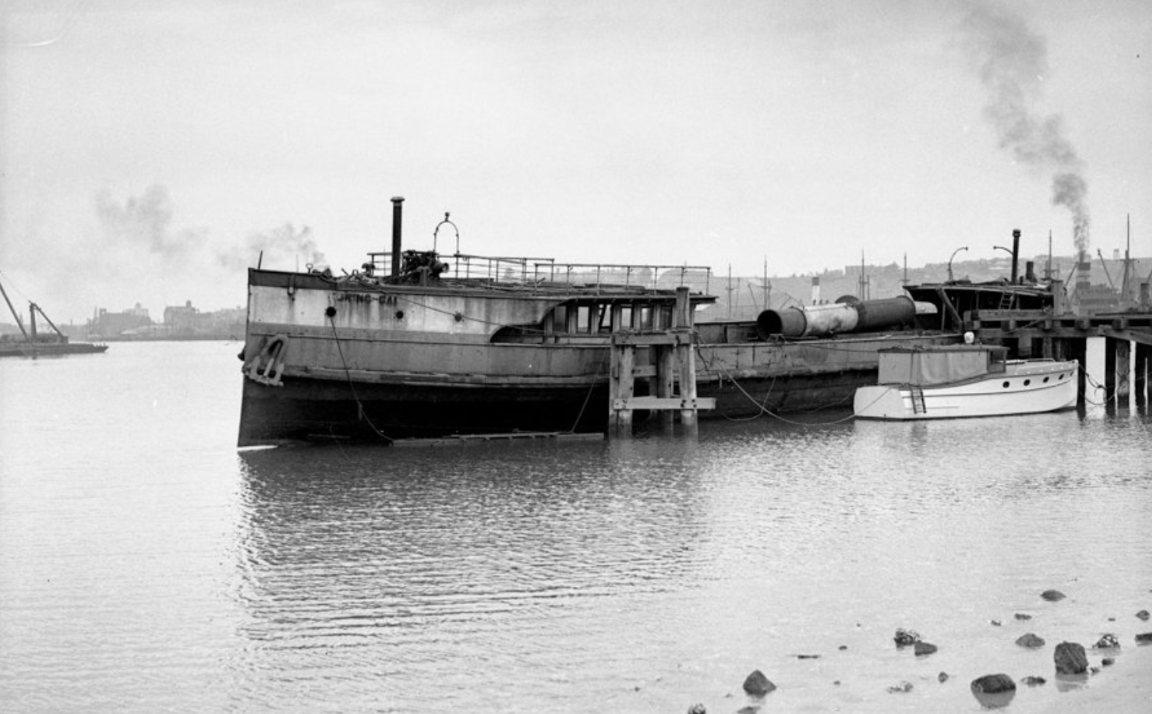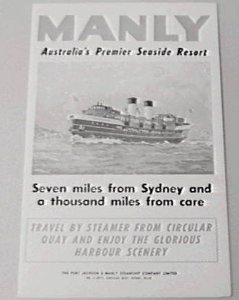|
Binngarra
''Binngarra'' was a ferry operated by Port Jackson & Manly Steamship Company on the Manly service. Launched in 1905, she was the first of six similar vessels built for the company–the ''Binngarra'' class—the success of which saw three of her sister vessels serving through to the 1970s and 1980s. Built by Mort's Dock and Engineering Co Ltd, in Woolwich, she was a double-ended screw steamer with steel hull and timber superstructure. She was decommissioned from ferry service in 1930. "Binngarra" is thought to be an Australia Aboriginal word for "spring" or "returning". It is sometimes misspelled as "Bingarra". Background The Port Jackson & Manly Steamship Company's fleet transitioned comparatively late to screw propelled vessels and the fleet comprised mostly paddle steamers until the early years of the twentieth century. The difficulty of turning in the narrow bays of Sydney Harbour - particularly in the busy Circular Quay terminus in Sydney Cove - required the use of doub ... [...More Info...] [...Related Items...] OR: [Wikipedia] [Google] [Baidu] |
List Of Sydney Harbour Ferries
Sydney Harbour's first ferries were sail and/or oar powered, but by the mid-19th century, paddle steamers were well established. Double-ended ferries became common as they did not require turning at terminating wharves in Sydney's busy but narrow bays, including at the main hub at Circular Quay. Double-ended ferries, however, provided technological challenges for screw (propeller) propulsion and Sydney's shift from paddle steamers to screw ferries in the closing years of the nineteenth century was relatively late. Diesel power first came to Sydney Harbour ferries mainly through the conversion of existing steam ferries to diesel in the 1930s and the 1950s, when during the slow post-Bridge decades ferry companies could generally not afford new ferries. Hydrofoils were introduced to the Manly run in the 1960s and 1970s halving travel times for those willing to pay a premium fare. Government investment in new vessels during the 1970s and 1980s saw the replacement of the surviving e ... [...More Info...] [...Related Items...] OR: [Wikipedia] [Google] [Baidu] |
MV North Head
The MV ''North Head'' (formerly SS ''Barrenjoey'') was a ferry operated by the Port Jackson & Manly Steamship Company and its successors on the Manly service from 1913 until 1985. The vessel was launched as ''Barrenjoey'', a steamer and one of the six ''Binngarra''-type Manly ferries which were built between 1905 and 1922. In 1951, she was converted to diesel-electric power, completely rebuilt and renamed ''North Head''. She was removed from service in 1985 following the introduction of the ''Freshwater''-class ferries. She spent time in Hobart as a floating restaurant and, in 2000, she was taken to Cairns where she remains grounded and in deteriorating condition. The name "Barrenjoey" was taken from the headland at the northern tip of Pittwater. "North Head" is the northern headland at the entrance to Sydney Harbour. Background The Port Jackson & Manly Steamship Company's fleet transitioned comparatively late to screw propelled vessels and the fleet comprised mostly pad ... [...More Info...] [...Related Items...] OR: [Wikipedia] [Google] [Baidu] |
Timeline Of Sydney Harbour Ferries
Sydney Harbour ferry services date back to the first years of Sydney's European settlement. Slow and sporadic boats ran along the Parramatta River from Sydney to Parramatta and served the agricultural settlements in between. By the mid-1830s, speculative ventures established regular services. From the late-nineteenth century the North Shore developed rapidly. A rail connection to Milsons Point took alighting ferry passengers up the North Shore line to Hornsby, New South Wales via North Sydney. Without a bridge connection, increasingly large fleets of steamers serviced the cross harbour routes and in the early twentieth century, Sydney Ferries Limited was the largest ferry operator in the world. However, arguably the most well-known is the Manly ferry service, and its large ship-like ferries that negotiate the beam swells of the Sydney Heads. From the mid-nineteenth century, the Port Jackson and Manly Steamship Company and its forerunners ran commuter and weekend excursion servi ... [...More Info...] [...Related Items...] OR: [Wikipedia] [Google] [Baidu] |
Baragoola
MV ''Baragoola'' was a ferry formerly operated by the Port Jackson & Manly Steamship Company and its successors on the Manly service. The sixth and final of the -type Manly ferries, the vessel entered service in 1922. Built with a triple-expansion steam engine, she was converted to diesel-electric propulsion in 1961. Since its decommissioning as a ferry in 1983, the vessel had a number of owners who attempted to find a new role and restore it. In 2003, it was laid up at Balls Head Bay on the north side of Sydney Harbour as attempts to restore the vessel continued. However, in January 2022, she sank at her mooring alongside the Balls Head Coal Loader, with the decision then made that the vessel would be scrapped. ''Baragoola'' is an Australian Aboriginal word for "flood tide". Background The Port Jackson & Manly Steamship Company's fleet transitioned comparatively late to screw-propelled vessels and the fleet comprised mostly paddle steamers until the early years of the twe ... [...More Info...] [...Related Items...] OR: [Wikipedia] [Google] [Baidu] |
SS Balgowlah
SS ''Balgowlah'' was a ferry on Sydney Harbour operated by the Port Jackson & Manly Steamship Company on the Manly service from 1912 until 1951. Background The Port Jackson & Manly Steamship Company's fleet transitioned comparatively late to screw propelled vessels and the fleet comprised mostly paddle steamers until the early years of the twentieth century. The difficulty of turning in the narrow bays of Sydney Harbour - particularly in the busy Circular Quay terminus in Sydney Cove - required the use of double-ended vessels. However, a double-ended screw configuration was particularly difficult for the fine bows that Manly ferries required for both speed and heavy seas. Further, a propeller at the leading forward end of a vessel reduced speed considerably. In the prosperous early twentieth century, this speed drawback was overcome by increasing engine size and power. The first screw ferries on the Manly run were two innovative Walter Reeks–designed vessels; the ''SS Manly' ... [...More Info...] [...Related Items...] OR: [Wikipedia] [Google] [Baidu] |
Dee Why-class Ferry
The ''Dee Why'' and ''Curl Curl'', were two identical steam ferries servicing Sydney Harbour's Circular Quay to Manly service. Both commissioned in 1928, they were the largest ferries on Sydney Harbour until the 1938 introduction of the ''South Steyne''. ''Curl Curl'' was the fastest ferry on the harbour, able to do the Manly run in 22 minutes. ''Dee Why'' was only marginally slower. The two ferries were built in Scotland and steamed to Sydney under their own power. The cost to build them in Australia was too high, so the company looked to Scotland for their new ships. ''Curl Curl'' served until 1960 while ''Dee Why'' was in service until 1968. The ferries were named after the Sydney suburbs of Dee Why and Curl Curl that lie north of Manly. Background In the 1920s, the Port Jackson & Manly Steamship Company ran a seven-ship fleet comprising the '' Kuring-gai'' and six similar Sydney-built double-ended screw steamers: ''Binngarra'' (1905), '' Burra Bra'' (1908), ''Bellubera'' ... [...More Info...] [...Related Items...] OR: [Wikipedia] [Google] [Baidu] |
Burra-Bra
''Burra Bra'' was a Manly ferry on Sydney Harbour that operated by the Port Jackson & Manly Steamship Company from 1908 until 1940, before being requisitioned by the Royal Australian Navy for use as an anti-submarine training vessel and target tow during World War II. "Burra-Bra" is an Australian Aboriginal name for The Spit in northern Sydney. Background The Port Jackson & Manly Steamship Company's fleet transitioned comparatively late to screw propelled vessels and the fleet comprised mostly paddle steamers until the early years of the twentieth century. The difficulty of turning in the narrow bays of Sydney Harbour - particularly in the busy Circular Quay terminus in Sydney Cove - required the use of double-ended vessels. However, a double-ended screw configuration was particularly difficult for the fine bows that Manly ferries required for both speed and heavy seas. Further, a propeller at the leading forward end of a vessel reduced speed considerably. In the prosper ... [...More Info...] [...Related Items...] OR: [Wikipedia] [Google] [Baidu] |
SS Manly
''Manly'' (II) was a ferry that served on the Sydney to Manly run from 1896 to 1924. Designed by renowned naval architect Walter Reeks, ''Manly'' was the first double-ended screw ferry on the Manly run. She, along with '' Kuring-gai'' (1901), were the archetypes for the long run of Manly ferries for most of the twentieth century. Background In the 1880s, the Port Jackson Steamship Company Limited had been expanding its paddle steamer fleet and services to Manly from Sydney (Circular Quay). Without competition, fares also rose. In response, local interests set up the Manly Co-operative Steam Ferry Limited in 1893 that ran a service with chartered single-ended screw steamers. While a price-war ensued, the new company's smaller and open vessels (''Cygnet'', ''Admiral'', ''Conqueror'', and ''Marramarra'') could not match Port Jackson's larger vessels, which included '' Brighton'', ''Fairlight'', ''Narrabeen''. However, patronage for both companies increased significantly. To entic ... [...More Info...] [...Related Items...] OR: [Wikipedia] [Google] [Baidu] |
SS Kuring-gai
''SS Kuring-gai'' was a ferry that served on the Sydney to Manly run from 1901 to 1928. An iron framed, steel-plated double-ended screw ferry, it was the archetype of the familiar Manly ferry shape of the 20th century. The name ''Kuring-gai'' is derived from the "Guringai" Aboriginal people who were thought to be the traditional owners of the area immediately north of Sydney. More contemporary research suggests that this was not the case. Design and construction ''Kuring-gai'' was ordered by the Port Jackson Co-operative Steamship Co. Ltd, which became the Port Jackson and Manly Steamship Company. The vessel was designed by renowned naval architect, Walter Reeks and was a development of Reeks' previous Manly ferry, the wooden '' Manly''. ''Kuring-gai's'' wheelhouses were located immediately adjacent either side of her single funnel. She was the first Manly ferry to have gangway exits on both upper and lower decks. The subsequent ''Binngarra''-type of vessels were larger ver ... [...More Info...] [...Related Items...] OR: [Wikipedia] [Google] [Baidu] |
Manly Ferry Services
Manly ferry services (numbered F1) operate on Sydney Harbour connecting the Sydney suburb of Manly with Circular Quay in the CBD a journey of seven nautical miles. History In 1853, Henry Gilbert Smith chartered the wooden paddle wheeler ''Brothers'' to bring people to the Manly area and thus boost the value of the subdivision of his land holdings near the Corso. The Manly area with its beaches and bays became a popular weekend destination and more ferries were chartered including by a local hotel owner. By 1855, the paddle steamer ''Emu'' (I) provided two daily weekday trips. ''Emu'' was followed by ''Black Swan'' and ''Pelican''. In 1859, the first double-ended ferry, ''Phantom'' commenced the service. She was a success, and the double-ended configuration remains the standard on the Manly route through to the present-day. Weekends and holidays were even busier than week days, and extra boats and tugs were put into service often as charters, including ''Goolwa'', ''Bread ... [...More Info...] [...Related Items...] OR: [Wikipedia] [Google] [Baidu] |
Port Jackson & Manly Steamship Company
The Port Jackson and Manly Steamship Company (PJ&MSC) was a publicly listed company that operated the Manly ferries in Sydney, Australia. After being taken over by Brambles Industries, the ferry service was eventually taken over by the State Government and is now part of Sydney Ferries. The company is notable for coining the expression about Manly being "Seven miles from Sydney and a thousand miles from care" and for promoting development in the Manly and Pittwater / Broken Bay areas. Formation The history of the PJ&MSC is entwined with the history of Manly itself. Manly had been envisaged as a seaside resort by Henry Gilbert Smith in the 1850s. Initially Smith had chartered a paddle steamer to Manly and other vessels visited on an ad hoc "excursion" basis. Smith built a wharf in 1855 and eventually acquired an interest in steamers himself and soon more regular services to Manly had commenced. By 1873 Smith had sold the lease to the wharf and his share of the steamers to ... [...More Info...] [...Related Items...] OR: [Wikipedia] [Google] [Baidu] |
Walter Reeks
Walter Reeks (1861-1925) was one of the earliest Naval architecture, naval architects in Australia and is known for designing yachts, ferries and coastal ships., He was born in Christchurch, Dorset, Christchurch, England and migrated to Australia in 1885. Reeks apprenticed with Alexander Richardson and at shipbuilders George Inman & Sons in England. He became an expert at yacht design and propulsion. He was active in the Sydney yachting community on arrival in Australia and joined several of the yacht clubs and engineering associations. He was Vice Commodore for the Royal Sydney Yacht Squadron from 1906 to 1910. He was president of the NSW Engineering Association in 1914. He worked for various Sydney ferry companies between 1890 and 1915 a period in which the ferry system saw significant growth. He designed the first double-ended screw Manly ferry, the ''SS Manly, Manly'' (II), and the ''SS Kuring-gai, Kuring-gai'', which became the model for Manly ferries of the first half o ... [...More Info...] [...Related Items...] OR: [Wikipedia] [Google] [Baidu] |






.jpg)




